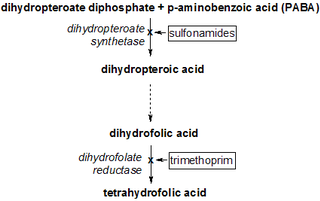Aminosalicylic acid can refer to any amino derivative of salicylic acid, such as:
- 3-Aminosalicylic acid
- 4-Aminosalicylic acid (para-aminosalicylic acid, PAS)
- 5-Aminosalicylic acid (mesalazine)
- 6-Aminosalicylic acid
Aminosalicylic acid can refer to any amino derivative of salicylic acid, such as:

Salicylic acid is an organic compound with the formula HOC6H4COOH. A colorless, bitter-tasting solid, it is a precursor to and a metabolite of aspirin (acetylsalicylic acid). It is a plant hormone, and has been listed by the EPA Toxic Substances Control Act (TSCA) Chemical Substance Inventory as an experimental teratogen. The name is from Latin salix for willow tree, from which it was initially identified and derived. It is an ingredient in some anti-acne products. Salts and esters of salicylic acid are known as salicylates.
PAS or Pas may refer to:
ATC code J04Antimycobacterials is a therapeutic subgroup of the Anatomical Therapeutic Chemical Classification System, a system of alphanumeric codes developed by the World Health Organization (WHO) for the classification of drugs and other medical products. Subgroup J04 is part of the anatomical group J Antiinfectives for systemic use.

Mesalazine, also known as mesalamine or 5-aminosalicylic acid (5-ASA), is a medication used to treat inflammatory bowel disease, including ulcerative colitis and Crohn's disease. It is generally used for mildly to moderately severe disease. It is taken by mouth or rectally. The formulations which are taken by mouth appear to be similarly effective.

Sulfasalazine, sold under the brand name Azulfidine among others, is a medication used to treat rheumatoid arthritis, ulcerative colitis, and Crohn's disease. It is considered by some to be a first-line treatment in rheumatoid arthritis. It is taken by mouth.

4-Aminosalicylic acid, also known as para-aminosalicylic acid (PAS) and sold under the brand name Paser among others, is an antibiotic primarily used to treat tuberculosis. Specifically it is used to treat active drug resistant tuberculosis together with other antituberculosis medications. It has also been used as a second line agent to sulfasalazine in people with inflammatory bowel disease such as ulcerative colitis and Crohn's disease. It is typically taken by mouth.
An aminosalicylate is a class of medications that is often used to treat ulcerative colitis and Crohn's disease. The class includes among others:
Coumaric acid is a phenolic derivative of cinnamic acid having a hydroxy group as substituent at one of the aromatic positions:
Linolenic acid is a type of naturally-occurring fatty acid. It can refer to either of two octadecatrienoic acids, or a mixture of the two. Linolenate is often found in vegetable oils; traditionally, such fatty acylates are reported as the fatty acids:

Balsalazide is an anti-inflammatory drug used in the treatment of inflammatory bowel disease. It is sold under the brand names Giazo, Colazal in the US and Colazide in the UK. It is also sold in generic form in the US by several generic manufacturers.
Aminobenzoic acid (a benzoic acid with an amino group) can refer to:
Nitrophenols are compounds of the formula HOC6H5−x(NO2)x. The conjugate bases are called nitrophenolates. Nitrophenols are more acidic than phenol itself.
A paser is a device which generates a coherent beam of electrons.

Salicylamide is a non-prescription drug with analgesic and antipyretic properties. Its medicinal uses are similar to those of aspirin. Salicylamide is used in combination with both aspirin and caffeine in the over-the-counter pain remedy PainAid. It was also an ingredient in the over-the-counter pain remedy BC Powder but was removed from the formulation in 2009, and Excedrin used the ingredient from 1960 to 1980 in conjunction with aspirin, acetaminophen, and caffeine. It was used in later formulations of Vincent's powders in Australia as a substitute for phenacetin.

Dihydropteroate synthase inhibitors are drugs that inhibit the action of dihydropteroate synthase. They include sulfonamides, dapsone, and para-aminosalicylic acid.
The molecular formula C7H7NO3 may refer to:
A codrug or "mutual prodrug" consists of two synergistic drugs chemically linked together to a single molecule, in order to improve the drug delivery properties of one or both drugs.
Trihydroxybenzoic acid may refer to the following phenolic acids:
An acid anhydride is a type of chemical compound derived by the removal of water molecules from an acid.
The hydroxycarboxylic acid receptor (abbreviated HCA receptor and HCAR) family includes the following human proteins: